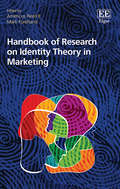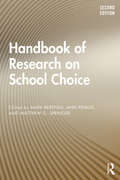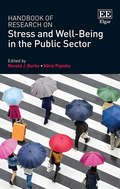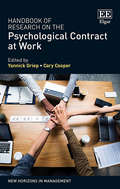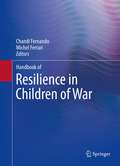- Table View
- List View
Handbook of Research on Identity Theory in Marketing (Research Handbooks in Business and Management series)
by Americus Reed Mark ForehandThe Handbook of Research on Identity Theory in Marketing features cutting-edge research that delves into the origins and consequences of identity loyalty and organizes these insights around five basic identity principles that span nearly every consumer marketing subdomain. The Handbook explores [1] what makes an identity come to mind [2] what creates strong associations between identities and products [3] how consumers use brands to verify who they are or want to become [4] how consumption enhances or resolves conflict amongst identities and [5] how marketing and consumption becomes particularly relevant to particular identities. Each of these five principles are fully analyzed by a who’s who of world-class international marketing scholars. This Handbook is a comprehensive and state of the art treatment of identity and marketing: An authoritative and practical guide for academics, brand managers, marketers, public policy advocates and even intellectually curious consumers.
Handbook Of Research On The Learning Organization: Adaptation And Context (Research Handbooks In Business And Management Ser. (PDF))
by Anders ÖrtenbladThis timely Handbook establishes the ÔcontextualizationÕ of the learning organization idea as a research field.In contrast to much of the previous literature, which has approached the learning organization as a panacea that every organization could and
Handbook of Research on School Choice
by Mark Berends Ann Primus Matthew G. SpringerUpdated to reflect the latest developments and increasing scope of school-based options, the second edition of the Handbook of Research on School Choice makes readily available the most rigorous and policy-relevant research on K–12 school choice. This comprehensive research handbook begins with scholarly overviews that explore historical, political, economic, legal, methodological, and international perspectives on school choice. In the following sections, experts examine the research and current state of common forms of school choice: charter schools, school vouchers, and magnet schools. The concluding section brings together perspectives on other key topics such as accountability, tax credit scholarships, parent decision-making, and marginalized students. With empirical perspectives on all aspects of this evolving sphere of education, this is a critical resource for researchers, faculty, and students interested in education policy, the politics of education, and educational leadership.
Handbook of Research on School Choice
by Mark Berends Ann Primus Matthew G. SpringerUpdated to reflect the latest developments and increasing scope of school-based options, the second edition of the Handbook of Research on School Choice makes readily available the most rigorous and policy-relevant research on K–12 school choice. This comprehensive research handbook begins with scholarly overviews that explore historical, political, economic, legal, methodological, and international perspectives on school choice. In the following sections, experts examine the research and current state of common forms of school choice: charter schools, school vouchers, and magnet schools. The concluding section brings together perspectives on other key topics such as accountability, tax credit scholarships, parent decision-making, and marginalized students. With empirical perspectives on all aspects of this evolving sphere of education, this is a critical resource for researchers, faculty, and students interested in education policy, the politics of education, and educational leadership.
Handbook of Research on Stress and Well-Being in the Public Sector (Research Handbooks in Business and Management series)
by Ronald J. Burke Silvia PignataThis timely Handbook addresses the concepts of stress and well-being among workers in various public sector roles and occupations across the globe. Emphasizing the importance of well-being and stress prevention initiatives in ever-changing workplace environments, this Handbook highlights successful organizational initiatives and provides insight into best practice for promoting healthy employees and workplaces. Chapters analyze the new and ongoing challenges public sector organizations face such as: cost cutting, pressures to improve performance, changes in societal and workplace demographics, and increasing levels of stress and strain amongst their employees. This wide-ranging Handbook utilizes empirical research, literature reviews and case studies to draw greater attention to these and other challenges. Containing contributions from leading international experts in their respective fields, the contributors hope that this multidisciplinary Handbook will help to enhance the health and well-being of public sector employees and the sector’s performance and contribution to society. The Handbook of Research on Stress and Well-Being in the Public Sector will be of value to researchers and practitioners interested in the public sector and both individual and organizational health and performance. This will also be a key resource for public sector and government professionals responsible for human resource management and work and health.
Handbook of Research on the Psychological Contract at Work (New Horizons in Management series)
by Cary Cooper Yannick GriepThe psychological contract is considered a critical construct in organizational behavior literature because it informs employee emotions, attitudes, and behaviors in the workplace. Although the psychological contract has been explored extensively over the last 50 years, numerous theoretical, conceptual, empirical, methodological, and analytical changes have pushed the field forward. As such, it is time to take stock and move forward. The contributors to this Handbook explore in detail this important component of modern management thinking. This volume’s objective is to challenge and refine the way scholars think about the psychological contract in the workplace by evaluating current assumptions embedded in psychological contract research, proposing new conceptual and theoretical developments, introducing dynamic psychological contract processes and offering new methodological and analytical developments. It concludes with a chapter, by leading researchers, outlining a proposed research agenda to further our understanding going forward. Academic audiences – faculty, graduate students – and others working in organizational behaviour and industrial and organizational psychology will value the theoretical aspects of this study as well as the new and exciting methodological propositions and elaborations. And evidence-based management practitioners will find interest in the chapters dealing with psychological contract breach and overcoming the aftermath of breach perceptions as they may inform policy and interventions.
Handbook of Resilience in Children of War
by Chandi Fernando and Michel FerrariTheir frightened, angry faces are grim reminders of the reach of war. They are millions of children, orphaned, displaced, forced to flee or to fight. And just as they have myriad possibilities for trauma, their lives also hold great potential for recovery.The Handbook of Resilience in Children of War explores these critical phenomena at the theoretical, research, and treatment levels, beginning with the psychosocial effects of exposure to war. Narratives of young people's lives in war zones as diverse as Afghanistan, Sri Lanka, Columbia, and Sudan reveal the complexities of their experiences and the meanings they attach to them, providing valuable keys to their rehabilitation. Other chapters identify strengths and limitations of current interventions, and of constructs of resilience as applied to youth affected by war. Throughout this cutting-edge volume, the emphasis is on improving the field through more relevant research and accurate, evidence-based interventions, in such areas as: An ecological resilience approach to promoting mental health in children of war.Child soldiers and the myth of the ticking time bomb.The Child Friendly Spaces postwar intervention program.The role of education for war-zone immigrant and refugee students.Political violence, identity, and adjustment in children.The Handbook of Resilience in Children of War is essential reading for researchers, scientist-practitioners, and graduate students in diverse fields including clinical child, school, and developmental psychology; child and adolescent psychiatry; social work; counseling; education; and allied medical and public health disciplines.
Handbook of Revolutions in the 21st Century: The New Waves of Revolutions, and the Causes and Effects of Disruptive Political Change (Societies and Political Orders in Transition)
by Jack A. Goldstone Leonid Grinin Andrey KorotayevThe 21st century has witnessed a considerable and increasing number of political revolutions around the world. This contradicts the popular belief of many experts in the 1970s that revolutions occurred mainly in monarchies and empires. Instead, the revolutions of this century have several new characteristics, which call for a renewed analysis of the subject.This handbook offers a comparative perspective on the new wave of revolutions of the last decade. Presenting case studies on the color revolutions, the Arab revolutions of 2010–2011, and the global wave of revolutions in 2013–2018 that spanned regions ranging from Africa to the Caucasus, it offers a better understanding of the varied forms, features, and historical backgrounds of revolutions, as well as their causes. Accordingly, it highlights recent revolutions in their historical and world-systems contexts.The handbook is divided into seven parts, the first of which examines the history of views on revolution and important aspects of the theory of revolution. The second part analyzes revolutions within long-term historical trends and in their world-system contexts. In turn, the third part explores specific major revolutionary waves in history. The fourth part analyzes the first revolutionary wave of the 21st century (2000–2009), the so-called color revolutions, while the fifth discusses the second wave – the Arab Spring (2010–2013) – as an important turning point. The sixth part is dedicated to analyzing revolutions and revolutionary movements beyond the Arab Spring and some revolutionary events from the third wave that began in 2018. The seventh and final part offers forecasts on the future of revolutions. Given its scope, the book will appeal to scholars and students from various disciplines interested in historical trends, sociopolitical change, contentious politics, social movements, and revolutionary processes involving both nonviolent campaigns and political violence. "Once again, this volume demonstrates the kind of open-minded, systematic analysis that the field of revolutionary studies requires." (Prof. George Lawson, Department of International Relations, Australian National University Canberra)
Handbook of Rural Aging
by Lenard W. KayeThe Handbook of Rural Aging goes beyond the perspective of a narrow range of health professions, disciplines, and community services that serve older adults in rural America to encompass the full range of perspectives and issues impacting the communities in which rural older adults live. Touching on such topics as work and voluntarism, technology, transportation, housing, the environment, social participation, and the delivery of health and community services, this reference work addresses the full breadth and scope of factors impacting the lives of rural elders with contributions from recognized scholars, administrators, and researchers. This Handbook buttresses a widespread movement to garner more attention for rural America in policy matters and decisions, while also elevating awareness of the critical circumstances facing rural elders and those who serve them.Merging demographic, economic, social, cultural, health, environmental, and political perspectives, it will be an essential reference source for library professionals, researchers, educators, students, program and community administrators, and practitioners with a combined interest in rural issues and aging.
Handbook of Rural Aging
by Lenard W. KayeThe Handbook of Rural Aging goes beyond the perspective of a narrow range of health professions, disciplines, and community services that serve older adults in rural America to encompass the full range of perspectives and issues impacting the communities in which rural older adults live. Touching on such topics as work and voluntarism, technology, transportation, housing, the environment, social participation, and the delivery of health and community services, this reference work addresses the full breadth and scope of factors impacting the lives of rural elders with contributions from recognized scholars, administrators, and researchers. This Handbook buttresses a widespread movement to garner more attention for rural America in policy matters and decisions, while also elevating awareness of the critical circumstances facing rural elders and those who serve them.Merging demographic, economic, social, cultural, health, environmental, and political perspectives, it will be an essential reference source for library professionals, researchers, educators, students, program and community administrators, and practitioners with a combined interest in rural issues and aging.
Handbook of Rural Health
by Sana Loue Beth E. QuillThis book integrates the expertise of profession tion available on the various health concerns and als from a broad array of disciplines-anthro subpopulations and by the numerous method pology, health services research, epidemiology, ological complexities in compiling the neces medicine, dentistry, health promotion, and so sary data. Recognition of the nuances within and cial work-in an examination of rural health across rural populations, as recommended here, care and rural health research. This investiga will allow us to provide care more efficiently tion includes an inquiry into issues that are uni and effectively and to prevent disease or ame versal across rural populations, such as public liorate its effects. Reliance on some of the newer health issues and issues of equity in health care. technologies and approaches discussed here, Several chapters explore the health care issues such as distance learning and broad-based, com that confront specified subpopulations includ munity-wide health initiatives, will facilitate ing, for instance, migrant workers and Native disease treatment and prevention in relatively Americans, while others provide a more focused isolated areas. Ultimately, all of us must work approach to diseases that may disproportionately to ensure the availability of adequate health care have an impact on residents of rural areas, such to even the most isolated communities, for "as as specific chronic and infectious diseases.
Handbook of School Mental Health: Research, Training, Practice, and Policy (Issues in Clinical Child Psychology)
by Mark D. Weist Nancy A. Lever Catherine P. Bradshaw Julie Sarno OwensWith so few therapeutic outlets readily available to young people, schools have evolved into mental health centers for many students. Yet schools are hampered by limited access to resources needed to provide mental health promotion, prevention, and intervention services.Like its acclaimed predecessor, the Second Edition of the Handbook of School Mental Health offers ways for professionals to maximize resources, make and strengthen valuable connections, and attain more effective school-based services and programming. At the same time, the Handbook provides strategies and recommendations in critical areas, such as workforce development, interdisciplinary collaborations, youth/family engagement, consultation, funding, and policy concerns, summarizes the state of current research, and offers directions for further study. Chapters model best practices for promoting wellness and safety, early detection of emotional and behavioral problems, and school-based interventions for students with anxiety, depression, attention deficit hyperactivity disorder, and other common challenges. In spotlighting this range of issues, the contributors have created a comprehensive game plan for advancing the field. Among the Handbook's topics:Pre-service training for school mental health clinicians.Cognitive-behavioral interventions for trauma in schools. Increasing parental engagement in school-based interventions.Models of psychiatric consultation to schools.Culturally competent behavioral and emotional screening. Bullying from a school mental health perspective.Prevention and intervention strategies related to a variety of mental health problems in schools. The Second Edition of the Handbook of School Mental Health is an essential reference for researchers, graduate students, and other professionals in child and school psychology, special and general education, public health, school nursing, occupational therapy, psychiatry, social work and counseling, educational policy, and family advocacy.
Handbook of Self-Regulation
by Monique Boekaerts Paul R. Pintrich Moshe ZeidnerThe Handbook of Self-Regulation represents state-of-the-art coverage of the latest theory, research, and developments in applications of self-regulation research. Chapters are of interest to psychologists interested in the development and operation of self-regulation as well as applications to health, organizational, clinical, and educational psychology.This book pulls together theory, research, and applications in the self-regulation domain and provides broad coverage of conceptual, methodological, and treatment issues. In view of the burgeoning interest and massive research on various aspects of self-regulation, the time seems ripe for this Handbook, aimed at reflecting the current state of the field. The goal is to provide researchers, students, and clinicians in the field with substantial state-of-the-art overviews, reviews, and reflections on the conceptual and methodological issues and complexities particular to self-regulation research. - Coverage of state-of-the-art in self-regulation research from different perspectives - Application of self-regulation research to health, clinical, organizational, and educational psychology - Brings together in one volume research on self-regulation in different subdisciplines - Most comprehensive and penetrating compendium of information on self-regulation from multi-disciplinary perspectives
Handbook of Self-Regulation
by Monique Boekaerts Moshe Zeidner Paul R. PintrichThe Handbook of Self-Regulation represents state-of-the-art coverage of the latest theory, research, and developments in applications of self-regulation research. Chapters are of interest to psychologists interested in the development and operation of self-regulation as well as applications to health, organizational, clinical, and educational psychology. This book pulls together theory, research, and applications in the self-regulation domain and provides broad coverage of conceptual, methodological, and treatment issues. In view of the burgeoning interest and massive research on various aspects of self-regulation, the time seems ripe for this Handbook, aimed at reflecting the current state of the field. The goal is to provide researchers, students, and clinicians in the field with substantial state-of-the-art overviews, reviews, and reflections on the conceptual and methodological issues and complexities particular to self-regulation research. - Coverage of state-of-the-art in self-regulation research from different perspectives - Application of self-regulation research to health, clinical, organizational, and educational psychology - Brings together in one volume research on self-regulation in different subdisciplines - Most comprehensive and penetrating compendium of information on self-regulation from multi-disciplinary perspectives
The Handbook of Sex Differences Volume I Basic Biology (The Handbook of Sex Differences)
by Lee Ellis Craig T. Palmer Rosemary Hopcroft Anthony W. HoskinThe Handbook of Sex Differences is a four-volume reference work assembled and written to assess sex differences in human traits (although findings regarding other species are also included). Based on the authors’ highly influential 2008 book Sex Differences, these volumes highlight important new research findings from the last decade and a half alongside earlier findings. Conclusions reached by meta-analyses are also included. In this, the work’s first volume, findings from thousands of studies are summarized regarding basic biology. Results having to do with sex ratios at birth and traits involving a wide range of bodily features are reported along with numerous complex aspects of biochemistry, neurology, and physical health. The eight chapters comprising Volume I are as follows: 1. Reproduction, Development, and Morphology 2. Anatomical and Physiological Factors 3. Bodily Fluids, Biochemicals, and Biochemical Receptors 4. The Brain: Structure and Functioning 5. Physical Health and Illness Factors 6. Responses to Physical and Chemical Environmental Factors 7. Responses to Stress and to Pain 8. Prenatal Factors The Handbook of Sex Differences is of significant importance for any researcher, student, or professional who requires a comprehensive resource on sex differences.
The Handbook of Sex Differences Volume I Basic Biology (The Handbook of Sex Differences)
by Lee Ellis Craig T. Palmer Rosemary Hopcroft Anthony W. HoskinThe Handbook of Sex Differences is a four-volume reference work assembled and written to assess sex differences in human traits (although findings regarding other species are also included). Based on the authors’ highly influential 2008 book Sex Differences, these volumes highlight important new research findings from the last decade and a half alongside earlier findings. Conclusions reached by meta-analyses are also included. In this, the work’s first volume, findings from thousands of studies are summarized regarding basic biology. Results having to do with sex ratios at birth and traits involving a wide range of bodily features are reported along with numerous complex aspects of biochemistry, neurology, and physical health. The eight chapters comprising Volume I are as follows: 1. Reproduction, Development, and Morphology 2. Anatomical and Physiological Factors 3. Bodily Fluids, Biochemicals, and Biochemical Receptors 4. The Brain: Structure and Functioning 5. Physical Health and Illness Factors 6. Responses to Physical and Chemical Environmental Factors 7. Responses to Stress and to Pain 8. Prenatal Factors The Handbook of Sex Differences is of significant importance for any researcher, student, or professional who requires a comprehensive resource on sex differences.
The Handbook of Sex Differences Volume II Cognitive Variables (The Handbook of Sex Differences)
by Lee Ellis Craig T. Palmer Rosemary Hopcroft Anthony W. HoskinThe Handbook of Sex Differences is a four-volume reference work assembled and written to assess sex differences in human traits (although findings regarding other species are also included). Based on the authors’ highly influential 2008 book Sex Differences, these volumes highlight important new research findings from the last decade and a half alongside earlier findings. Conclusions reached by meta-analyses are also included. This, the work’s second volume, summarizes results from thousands of studies pertaining to cognition, broadly defined. Variables related to perceptual and motor skills, emotions, intellectual abilities, and mental disorders are among those examined. Even sex differences in attitudes, beliefs, preferences, and interests are documented in this volume. The seven chapters comprising Volume II are as follows: 9. Perceptual Abilities and Motor Functioning 10. Emotional Factors 11. Cognitive, Academic, and Intellectual Factors 12. Learning, Memory, Knowledge, and Cognitive States 13. Self-Assessments and States Of Mind 14. Mental Health and Illness 15. Attitudes, Beliefs, Interests, and Preferences The Handbook of Sex Differences is of importance for any researcher, student, or professional who requires a comprehensive resource on sex differences.
The Handbook of Sex Differences Volume II Cognitive Variables (The Handbook of Sex Differences)
by Lee Ellis Craig T. Palmer Rosemary Hopcroft Anthony W. HoskinThe Handbook of Sex Differences is a four-volume reference work assembled and written to assess sex differences in human traits (although findings regarding other species are also included). Based on the authors’ highly influential 2008 book Sex Differences, these volumes highlight important new research findings from the last decade and a half alongside earlier findings. Conclusions reached by meta-analyses are also included. This, the work’s second volume, summarizes results from thousands of studies pertaining to cognition, broadly defined. Variables related to perceptual and motor skills, emotions, intellectual abilities, and mental disorders are among those examined. Even sex differences in attitudes, beliefs, preferences, and interests are documented in this volume. The seven chapters comprising Volume II are as follows: 9. Perceptual Abilities and Motor Functioning 10. Emotional Factors 11. Cognitive, Academic, and Intellectual Factors 12. Learning, Memory, Knowledge, and Cognitive States 13. Self-Assessments and States Of Mind 14. Mental Health and Illness 15. Attitudes, Beliefs, Interests, and Preferences The Handbook of Sex Differences is of importance for any researcher, student, or professional who requires a comprehensive resource on sex differences.
The Handbook of Sex Differences Volume III Behavioral Variables (The Handbook of Sex Differences)
by Lee Ellis Craig T. Palmer Rosemary Hopcroft Anthony W. HoskinThe Handbook of Sex Differences is a four-volume reference work assembled and written to assess sex differences in human traits (although findings regarding other species are also included). Based on the authors’ highly influential 2008 book Sex Differences, these volumes highlight important new research findings from the last decade and a half alongside earlier findings. Conclusions reached by meta-analyses are also included. In this, the work’s third volume, findings from thousands of studies pertaining to behavior, broadly defined, are summarized. Traits covered include those involving personality, social behavior, criminality, work, and sex stereotypes. The eight chapters comprising Volume III are as follows: 16. Personality and Behavioral Tendencies 17. Social Behavior 18. Acquiring, Selling, and Consuming Behavior 19. Criminality, Near-Criminality, and Victimization 20. Education, Work, Social Status, and Territorial Behavior 21. Sex Stereotypes 22. Attitudes and Actions Toward Others According to their Sex 23. Ecologically Based Sex Differences The Handbook of Sex Differences is of significant importance for any researcher, student, or professional who requires a comprehensive resource on sex differences.
The Handbook of Sex Differences Volume III Behavioral Variables (The Handbook of Sex Differences)
by Lee Ellis Craig T. Palmer Rosemary Hopcroft Anthony W. HoskinThe Handbook of Sex Differences is a four-volume reference work assembled and written to assess sex differences in human traits (although findings regarding other species are also included). Based on the authors’ highly influential 2008 book Sex Differences, these volumes highlight important new research findings from the last decade and a half alongside earlier findings. Conclusions reached by meta-analyses are also included. In this, the work’s third volume, findings from thousands of studies pertaining to behavior, broadly defined, are summarized. Traits covered include those involving personality, social behavior, criminality, work, and sex stereotypes. The eight chapters comprising Volume III are as follows: 16. Personality and Behavioral Tendencies 17. Social Behavior 18. Acquiring, Selling, and Consuming Behavior 19. Criminality, Near-Criminality, and Victimization 20. Education, Work, Social Status, and Territorial Behavior 21. Sex Stereotypes 22. Attitudes and Actions Toward Others According to their Sex 23. Ecologically Based Sex Differences The Handbook of Sex Differences is of significant importance for any researcher, student, or professional who requires a comprehensive resource on sex differences.
The Handbook of Sex Differences Volume IV Identifying Universal Sex Differences (The Handbook of Sex Differences)
by Lee Ellis Craig T. Palmer Rosemary Hopcroft Anthony W. HoskinThe Handbook of Sex Differences is a four-volume reference work written to assess sex differences, with a primary focus on the human species. Based on the authors’ highly influential 2008 book Sex Differences, these volumes highlight important new research findings from the last decade and a half alongside earlier findings. In this, the work’s fourth and last volume, two related questions are addressed: Are there universal sex differences (i.e., sex differences found in all societies)? And if the answer is yes, what are they and how can each one be theoretically explained? To answer the first of these two questions, this volume condenses much of the research findings amassed in the book’s first three volumes into summary tables. Then, to help identify likely universal sex differences, three versions of social role theory and two versions of evolutionary theory are examined relative to each possible universal sex difference. Consideration is even given to religious scriptures as a sixth type of explanation. In the concluding analyses, 308 likely universal sex differences are identified. No single theory was able to explain all these differences. Nevertheless, the two evolutionary theories were better in this regard than any of the three social role theories, including the recently proposed biosocial version of social role theory. The Handbook of Sex Differences is of importance for any researcher, student, or professional who requires a comprehensive resource on sex differences.
The Handbook of Sex Differences Volume IV Identifying Universal Sex Differences (The Handbook of Sex Differences)
by Lee Ellis Craig T. Palmer Rosemary Hopcroft Anthony W. HoskinThe Handbook of Sex Differences is a four-volume reference work written to assess sex differences, with a primary focus on the human species. Based on the authors’ highly influential 2008 book Sex Differences, these volumes highlight important new research findings from the last decade and a half alongside earlier findings. In this, the work’s fourth and last volume, two related questions are addressed: Are there universal sex differences (i.e., sex differences found in all societies)? And if the answer is yes, what are they and how can each one be theoretically explained? To answer the first of these two questions, this volume condenses much of the research findings amassed in the book’s first three volumes into summary tables. Then, to help identify likely universal sex differences, three versions of social role theory and two versions of evolutionary theory are examined relative to each possible universal sex difference. Consideration is even given to religious scriptures as a sixth type of explanation. In the concluding analyses, 308 likely universal sex differences are identified. No single theory was able to explain all these differences. Nevertheless, the two evolutionary theories were better in this regard than any of the three social role theories, including the recently proposed biosocial version of social role theory. The Handbook of Sex Differences is of importance for any researcher, student, or professional who requires a comprehensive resource on sex differences.
Handbook of Sex Trafficking: Feminist Transnational Perspectives
by Kalyani Gopal Lenore Walker Giselle GaviriaThis definitive reference assembles the current knowledge base on the scope and phenomena of sex trafficking as well as best practices for treatment of its survivors. A global feminist framework reflects a profound understanding of the entrenched social inequities and ongoing world events that fuel trafficking, including in its lesser-known forms. Empirically sound insights shed salient light on who buyers and traffickers are, why some survivors become victimizers, and the experiences of victim subpopulations (men, boys, refugees, sexual minorities), as well as emerging trends in prevention and protection, resilience and rehabilitation. These powerful dispatches also challenge readers to consider complex questions found at the intersections of gender, race, socioeconomic status, and politics. A sampling of topics in the Handbook: · An organizational systems view of sex trafficking. · Vulnerability factors when women and girls are trafficked. · Men, boys, and LGBTQ: invisible victims of human trafficking. · Organized crime, gangs, and trafficking. · Human trafficking prevention efforts for kids (NEST). · Treating victims of human trafficking: core therapeutic tasks. · From Trafficked to Safe House (C-SAFE). The Handbook of Sex Trafficking will interest a wide professional audience, particularly mental health workers, legal professionals, and researchers in these and related fields. Public health and law enforcement professionals will also find it an important resource.
Handbook of Sexuality-Related Measures
by Terri D. Fisher Clive M. Davis William L. Yarber Robin Milhausen John SakalukThis classic and invaluable reference handbook, written for sex researchers and their students, has now been completely revised in a new, fourth edition. It remains the only easy and efficient way for researchers to learn about, evaluate, and compare instruments that have previously been used in sex research.
Handbook of Sexuality-Related Measures
by Terri D. Fisher Clive M. Davis William L. Yarber Robin Milhausen John SakalukThis classic and invaluable reference handbook, written for sex researchers and their students, has now been completely revised in a new, fourth edition. It remains the only easy and efficient way for researchers to learn about, evaluate, and compare instruments that have previously been used in sex research.
